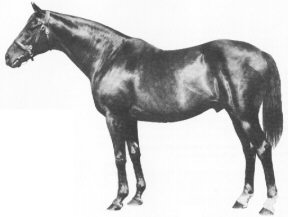"...Historically, breeders have had to rely on conformation and progeny performance records to predict a physical trait's heritability. Advances in technology and gene identification have led to the availability of tests that help determine if the sire and/or dam has actually passed on specific genetic markers for performance. With potentially better odds of acquiring a highly talented horse, there has been much interest in identifying genetic variables that impact racing performance.
Ernest Bailey, PhD, professor at the University of Kentucky's Maxwell H. Gluck Equine Research Center, in Lexington, is involved with The Horse Genome Project. He says several laboratories have investigated racing performance and the MSTN (myostatin) gene. They have identified two alleles (different forms of a gene at one chromosome location) on the MSTN gene-the T-allelAmerican Quarter Horse or Quarter Horse for distance and the C-allele for sprinting. The T-variant is common in Arabian lines that produce successful endurance horses. In contrast, Quarter Horses have a high frequency of the C-allele for sprinting, whereas Thoroughbreds have a mix of the two. ...
 ...Researchers have found that myostatin mutations are associated with increased muscling, distribution of fast-twitch muscle fibers, and hindquarter power. Practically applied, looking at pedigrees of Thoroughbreds that excel as 2-year-olds in elite middle-distance (8-to 12--furlong, with a furlong being 1/8 mile) races, common sires include great 20th-century stallion Nearco and his sons Nearctic, Nasrullah, and Royal Charger. All these horses' genes contain the C-allele of the myostatin gene, which confers early muscling and speed in 2-year-olds. The myostatin gene profile can help predict an individual's best distance, but researchers caution not to consider it a speed gene or use it to define a horse's racing class. ..."
...Researchers have found that myostatin mutations are associated with increased muscling, distribution of fast-twitch muscle fibers, and hindquarter power. Practically applied, looking at pedigrees of Thoroughbreds that excel as 2-year-olds in elite middle-distance (8-to 12--furlong, with a furlong being 1/8 mile) races, common sires include great 20th-century stallion Nearco and his sons Nearctic, Nasrullah, and Royal Charger. All these horses' genes contain the C-allele of the myostatin gene, which confers early muscling and speed in 2-year-olds. The myostatin gene profile can help predict an individual's best distance, but researchers caution not to consider it a speed gene or use it to define a horse's racing class. ..."

